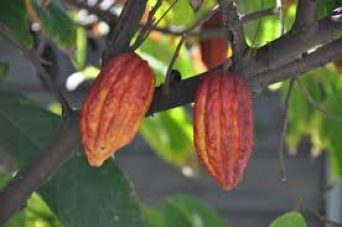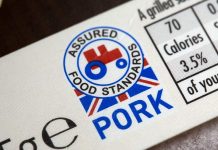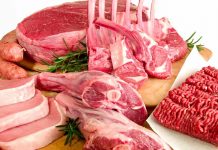Abstract
The performance of weaner pigs (n=50; initial live weight 10kg) fed increasing levels (0, 10, 20, 30 and 40%) of cocoa bean shell meal replacing maize was investigated in a twelve week feeding trial.
Feed intake was not affected but live weight gain decreased when the cocoa shell meal exceeded 20% of the diet. Feed conversion was poorer when the cocoa shell meal exceeded 10% of the diet.
Introduction
One of the major challenges responsible for high cost of intensive pig production in Nigeria is the dependency on maize as the major energy source in the diet. Maize, the 3rd most produced food crop in Nigeria after cassava and yam in Nigeria still experience fluctuation in its production from 8,878,456 in 2011 to 8,422,620 in 2013, increasing to 10,790,600 in 2014 and decreasing to7,200,475 metric tonnes in 2016 (USDA 2016; World Data Atlas 2014). Pathetically, about 95% of maize produced in Nigeria is consumed with the remaining 5% for industrial purpose and as animal feed ingredient. Thus, about 3,000,000 metric tonnes of maize are imported annually (from 2014 to 2016) to the country. In spite of the importation, supply is still short of demand leaving the livestock sub sector at the receiving end. To sustain the livestock sub sector, the need to source for alternatives to maize as energy source in their diet becomes imperative. Studies had been conducted on the utilization of agro-based wastes such as cassava wastes (Akinfala and Tewe 2004; Adesehinwa et al 2008), brewer’s wastes (Aguilera-Soto et al 2008), sugar beet wastes (Martine et al 2015), food wastes (Saika and Bhar 2010), palm kernel meal (Fatufe et al 2007) among others in pigs diets. Of all these wastes, none has been universally accepted as alternative to maize as energy source in pig diet.
Another agro waste of importance is cocoa bean shell. Cocoa bean shell (CBS), a by-product of cocoa bean in chocolate, beverage and cocoa factories, is estimated at about 10,500 metric tonnes per annum and forms about 70% of the waste (FAO, 2002). This product is presently of no economic benefit and thus constitutes waste and environmental concern to the factory and host community. Thus, the present study assessed the feed intake and weight gain of weaner pigs on dietary inclusion of cocoa bean shell meal with the aim to mitigate the environmental concerns occasioned by the unwholesome dumping of these waste to the immediate environment.
Materials and methods
Experimental site
This research was carried out at the Pig Unit, Department of Agricultural Science, Adeyemi College of Education, Ondo lies between latitude 070 051N and 04o551E in the forest zone of Nigeria with temperature ranged from 22-350C and annual rain fall 1800-3600 mm, spreading between March and October.
Collection and processing of cocoa bean shell
The cocoa bean shells (CBS) were collected from Stamack Cocoa Processing Industries, Ondo, Nigeria. They were bagged and stored in a cool dry place prior use.
Chemical composition determination
The dried and milled CBS were analyzed for dry matter (DM) by oven drying method, ash by muffle furnace, crude protein (CP) by kjedahl method, ether extract (EE) by soxhlet fat analysis, crude fibre (CF) by acid and alkaline hydrolysis as described by AOAC (2002). Theobromine determination was by the method of Gerritsma and Koers (1953). Gross energy (GE) was by the Gallenkamp Adiabatic Bomb Calorimeter (Model CBB-330-0104).
Feed preparation
The experimental diets (Table 1) were prepared in College Feed Mill. Five diets were formulated such that diet 1 which is the basal diet contained 0% CBS meal while diets 2, 3, 4 and 5 contained 10, 20, 30 and 40% dietary CBS meal, respectively.
|
|||||
| Ingredients, kg |
Cocoa bean shell meal, % in the diet |
||||
|
0 |
10 |
20 |
30 |
40 |
|
| Maize |
56.2 |
50.6 |
45.0 |
39.3 |
33.7 |
| Cocoa bean shell |
– |
5.6 |
11.2 |
16.9 |
22.5 |
| Wheat offal |
9.00 |
9.00 |
9.00 |
9.00 |
9.00 |
| Soybean meal |
14.00 |
14.00 |
14.00 |
14.00 |
14.00 |
| Groundnut cake |
8.00 |
8.00 |
8.00 |
8.00 |
8.00 |
| Palm kernel cake |
7.00 |
7.00 |
7.00 |
7.00 |
7.00 |
| Fish meal |
2.50 |
2.50 |
2.50 |
2.50 |
2.50 |
| Bone meal |
1.50 |
1.50 |
1.50 |
1.50 |
1.50 |
| Oyster shell |
0.50 |
0.50 |
0.50 |
0.50 |
0.50 |
| Premix |
0.50 |
0.50 |
0.50 |
0.50 |
0.50 |
| Lysine |
0.15 |
0.15 |
0.15 |
0.15 |
0.15 |
| Methionine |
0.15 |
0.15 |
0.15 |
0.15 |
0.15 |
| Salt |
0.50 |
0.50 |
0.50 |
0.50 |
0.50 |
| Total |
100 |
100 |
100 |
100 |
100 |
Experimental design
The experimental design was the completely randomized CRD with five treatments replicated ten times with one weanling pig per treatment/replicate.
Management of the animals
Fifty weaner pigs of crossbreed and mixed sexes were used for the feeding trial. The pigs were given one week period of adaptation during which they were fed commercial grower diet and treated against parasitic infection by 0.5ml Ivermectin injected intramuscularly. After the adaptation period, they were randomly assigned to their respective diets. The animals were fed at 5% body weight with water served ad-libitum throughout the 84 days feeding trial.
Data collection and analysis
Data on feed intake, weight change and feed conversion were analyzed by one way analysis of variance (ANOVA) using SPSS 2006. Where significant differences existed, the means were separated using Duncan new Multiple Range Test (Duncan 1955).
Results and discussion
Chemical composition
Compared with maize, the cocoa bean shell has about 50% higher levels of crude protein and twice the level of ether extract, but twenty times the level of crude fiber (Table 2)
| Table 2. Chemical composition of cocoa bean shell compared with maize (% in DM, unless indicated otherwise) | ||
|
Cocoa bean shell |
Maize grain # |
|
| Dry matter |
93.5 |
|
| Crude protein |
15.4 |
9.4 |
| Crude fiber |
39.3 |
2.5 |
| Ether extract |
8.49 |
4.3 |
| Ash |
5.17 |
1.4 |
| Theobromine (g/kg) |
2.88 |
|
Performance indices
Feed intake was not affected by increasing levels of cocoa shell meal replacing maize indicating that the former was palatable, perhaps because of the chocolate odor and crispy texture (Odunsi and Longe 1995).
Final live weight and average weight gain decreased when the level of cocoa bean shell exceeded 20% of the diet, replacing maize (Table 3). Feed conversion was poorer on all diets with more than 10% cocoa shell meal. The presence of theobromine has been implicated as a factor limiting the feeding value of cocoa shell meal (Day and Dilworth 1984; Adamafio 2013), but it is more likely that the depression in growth rate and feed conversion was due to reduced digestibility as crude fiber in the cocoa shell meal replaced the starch in maize grain. This depression in growth rate could be connected with the dilution of the nutrients occasioned by successive inclusion of fibrous cocoa bean shell meal in place of maize (Ojewola et al 2006).
| Table 3. Mean values for feed intake, live weight gain and feed conversion for pigs fed increasing levels of cocoa bean shell meal replacing maize | |||||||
| Performance characteristics |
Cocoa bean shell meal, % in the diet |
SEM |
p |
||||
|
0 |
10 |
20 |
30 |
40 |
|||
| Live weight, kg | |||||||
| Initial |
9.98 |
9.97 |
10.10 |
9.93 |
9.93 |
0.17 |
0.52 |
| Final |
44.8a |
45.3a |
43.6a |
38.5b |
39.5b |
3.05 |
<0.003 |
| Daily gain |
0.415a |
0.421a |
0.399a |
0.340b |
0.352b |
0.04 |
<0.001 |
| Feed intake, kg/d |
1.10 |
1.14 |
1.14 |
1.09 |
1.07 |
0.03 |
0.19 |
| Feed conversion |
2.69a |
2.71a |
2.83b |
3.22c |
3.07d |
0.32 |
<0.002 |
| abcde Means without common superscripts along the same row differ at P< 0.05 | |||||||
Conclusions
- Result shows that 20% was the optimal biological level of CBS meal as energy substitute for maize in pig diet.
- Pig farmers in this part of the world where CBS abound are encouraged to utilize this waste in pig diet.





